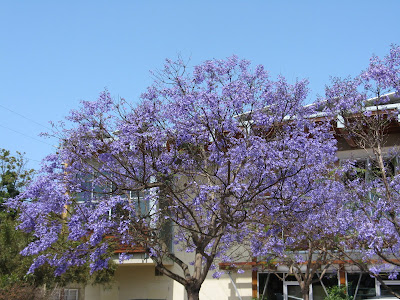The technical name for these trees is jacaranda mimosifolia, or the "blue jacaranda". Originally native to South America, the sub-tropical tree thrives in frost-free regions across the world, from parts of the American South to Australia (who have a Christmas song about the jacaranda, and often refer to the trees as "exam trees" due to the fact that by the time they blossom, it's too late for Sydney University students to begin studying for their finals), and South Africa, where Pretoria is known as Jakarandastad (or "Jacaranda City") because of the enormous amount of blooms that turn the city blue each spring. I first discovered the jacaranda when making the cross-country drive from Albany, NY to San Diego in late May. From the snarling freeways darting through Los Angeles, I spotted acres of gorgeous violet/purple tapestries decorating mall parking lots, side streets and park edges. When the colors vanished suddenly as June neared its end, I felt as if I had lost a great part of what most attracted me to the area. Yet, as spring nears its end, they return.
For much of the year, it's easy to forget that jacarandas even exist. When stripped of their blooms, they are a bland and forgettable species of tree.
It's only when they begin filling in their spindly branches that most of us remember what they have in store for us.
















2 comments:
Sure a sign of spring as any...
Great photos.
Mom and I were taken by this flowering tree when we visited California two years ago. There's something striking about the vibrant blue of the Jacaranda that makes a lifelong impression on the observer. Like the North American Bluebird or Indigo Bunting the beautiful blossoms are captivating.
Dad
Post a Comment